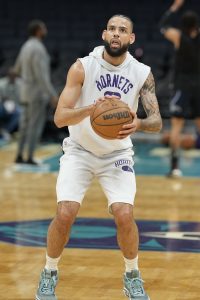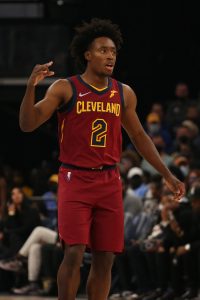Players eligible for restricted free agency don’t become restricted free agents by default. In order to make a player a restricted free agent, a team must extend a qualifying offer to him — a player who doesn’t receive one becomes an unrestricted free agent instead.
The qualifying offer, which is essentially just a one-year contract offer, varies in amount depending on a player’s service time and previous contract status.
If a player reaches free agency with three or fewer years of NBA service time under his belt, his qualifying offer is worth 125% of his prior salary, or his minimum salary plus $200K, whichever is greater.
 For instance, after earning $1,782,621 this season, Hornets wing Cody Martin projects to have a minimum salary worth $1,876,674 in 2022/23. Adding $200K to that figure works out to $2,076,674, whereas 125% of his prior salary is $2,228,276. His qualifying offer will be worth the higher amount ($2,228,276).
For instance, after earning $1,782,621 this season, Hornets wing Cody Martin projects to have a minimum salary worth $1,876,674 in 2022/23. Adding $200K to that figure works out to $2,076,674, whereas 125% of his prior salary is $2,228,276. His qualifying offer will be worth the higher amount ($2,228,276).
On the other hand, a player like Wizards forward Anthony Gill earned a $1,517,981 salary in 2021/22. Calculating 125% of that amount works out to $1,897,476, whereas his projected minimum salary ($1,811,516) plus $200K would be $2,011,516.
The precise value of Gill’s qualifying offer will depend on where exactly the ’21/22 salary cap ends up, since minimum salaries increase or decrease at the same rate as the cap, but it’s a safe bet his QO will be worth his minimum salary plus $200K.
For a player earning the minimum or something close to it, it’s not always immediately apparent which formula will render the higher qualifying offer. However, it’s more obvious for players earning well above the minimum, such as Nuggets guard Facundo Campazzo. He’ll be eligible for restricted free agency this offseason after earning $3.2MM in 2021/22, and his qualifying offer will be worth 125% of his previous salary: $4MM.
The qualifying offer for a former first-round pick coming off his rookie scale contract is determined by his draft position. The qualifying offer for a first overall pick is 130% of his fourth-year salary, while for a 30th overall pick it’s 150% of his previous salary — QOs for the rest of the first-rounders fall somewhere in between. The full first-round scale for the draft class of 2018, whose first-rounders will be hitting free agency this summer, can be found here, courtesy of RealGM.
Here are a pair of examples for this offseason: 2018’s first overall pick, Suns center Deandre Ayton, is coming off a fourth-year salary of $12,632,950, so he must be extended a qualifying offer of $16,422,835 (a 30% increase) to become a restricted free agent. Meanwhile, the 24th overall pick, Trail Blazers guard Anfernee Simons, will be eligible for a qualifying offer of $5,758,552, a 46.2% increase on this season’s $3,938,818 salary.
A wrinkle in the Collective Bargaining Agreement complicates matters for some RFAs-to-be, since a player’s previous usage can impact the amount of his qualifying offer. Certain players who meet – or fail to meet – the “starter criteria,” which we break down in a separate glossary entry, become eligible for higher or lower qualifying offers. Here’s how the starter criteria affects QOs:
- A top-14 pick who does not meet the starter criteria will receive a same qualifying offer equal to 120% of the amount applicable to the 15th overall pick.
- Note: In 2022, the value of this QO will be $7,228,448.
- A player picked between 10th and 30th who meets the starter criteria will receive a qualifying offer equal to 120% of the amount applicable to the ninth overall pick.
- Note: In 2022, the value of this QO will be $7,921,300.
- A second-round pick or undrafted player who meets the starter criteria will receive a qualifying offer equal to 100% of the amount applicable to the 21st overall pick.
- Note: In 2022, the value of this QO will be $4,869,012.
 Cavaliers guard Collin Sexton is one example of a player who falls into the first group, since he didn’t meet the starter criteria this year. The No. 8 overall pick in 2018, Sexton will be eligible this offseason for a QO worth $7,228,448 instead of $8,559,357.
Cavaliers guard Collin Sexton is one example of a player who falls into the first group, since he didn’t meet the starter criteria this year. The No. 8 overall pick in 2018, Sexton will be eligible this offseason for a QO worth $7,228,448 instead of $8,559,357.
Conversely, Hornets forward Miles Bridges (a former No. 12 overall pick) met the starter criteria and will now be eligible for a QO worth $7,921,300 instead of $7,459,974.
[RELATED: Potential 2022 RFAs Whose Qualifying Offers Will Be Impacted By Starter Criteria]
A qualifying offer is designed to give a player’s team the right of first refusal. Because the qualifying offer acts as the first formal contract offer a free agent receives, his team then receives the option to match any offer sheet the player signs with another club.
A player can also accept his qualifying offer, if he so chooses. He then plays the following season on a one-year contract worth the amount of the QO, and becomes an unrestricted free agent at season’s end, assuming he has at least four years of NBA experience. A player can go this route if he wants to hit unrestricted free agency as early as possible, or if he feels like the QO is the best offer he’ll receive. Accepting the qualifying offer also gives a player the right to veto trades for the season.
Nets guard Bruce Brown was the only noteworthy restricted free agent to accept his qualifying offer during the 2021 offseason. As a result, he’ll be an unrestricted free agent in 2022.
Finally, while the details outlined above apply to players on standard NBA contracts who are eligible for restricted free agency, a different set of rules applies to players coming off two-way contracts. For most of those players, the qualifying offer would be equivalent to a one-year, two-way salary, with $50K guaranteed.
A player who is coming off a two-year, two-way deal, has already been on two-way deals with his current team for at least two seasons, or has accumulated four years of NBA service would be eligible for a qualifying offer equivalent to a standard, minimum-salary NBA contract. The guarantee on that QO would have to match or exceed a two-way salary.
Note: This is a Hoops Rumors Glossary entry. Our glossary posts will explain specific rules relating to trades, free agency, or other aspects of the NBA’s Collective Bargaining Agreement. Larry Coon’s Salary Cap FAQ and salary information from Basketball Insiders was used in the creation of this post. Earlier versions of this post were published in previous years.